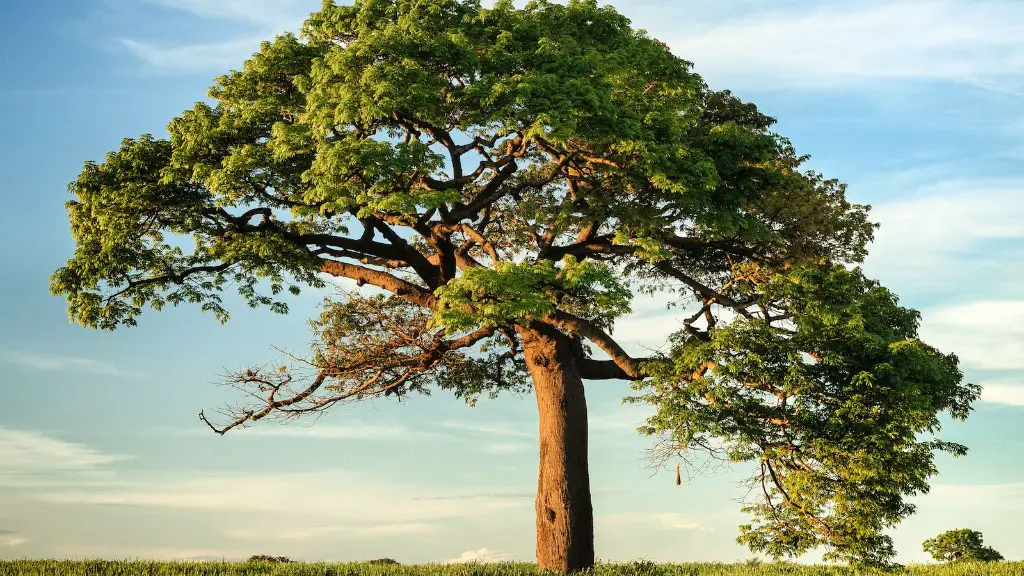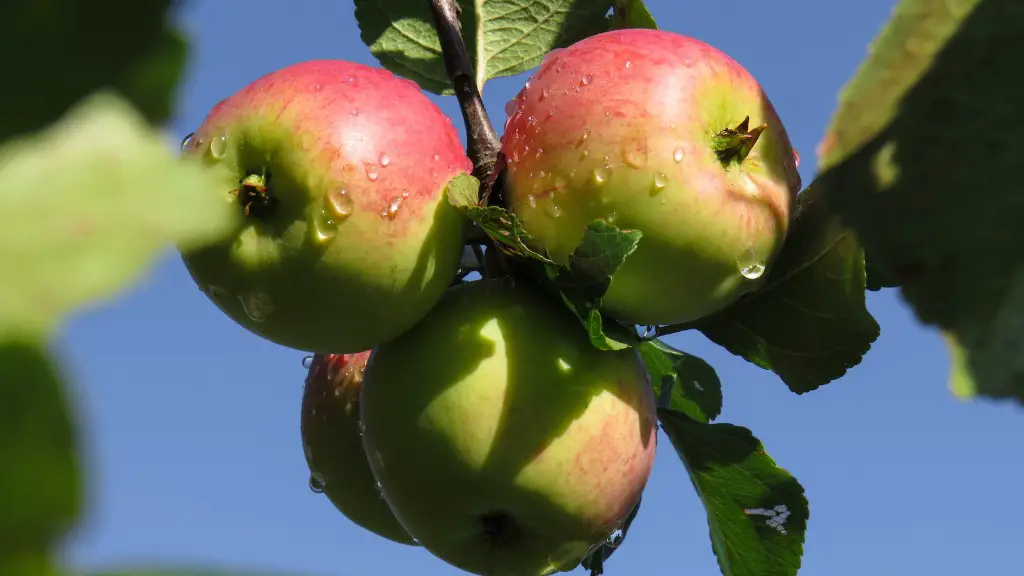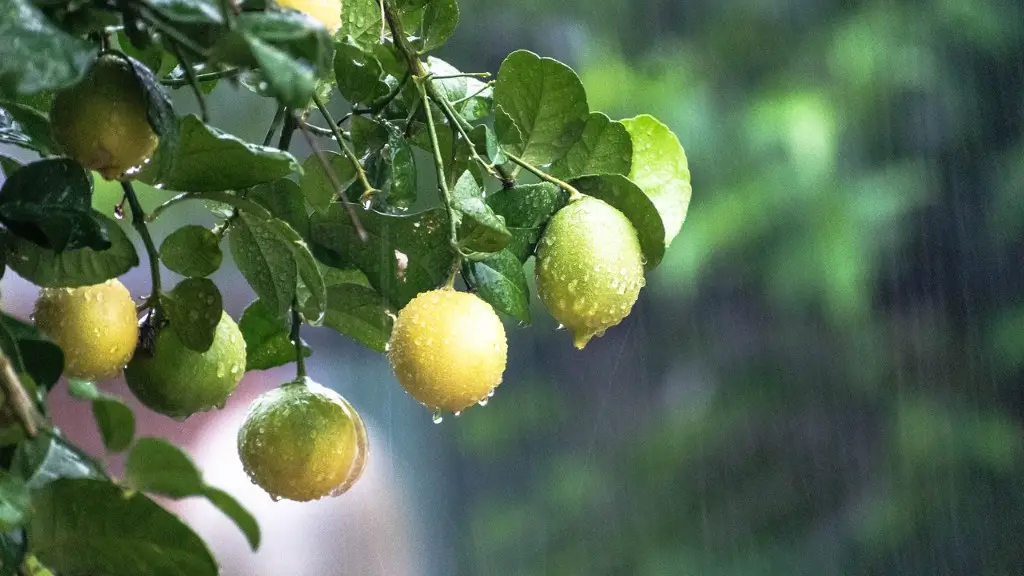Growing a lemon tree in a container is quite easy and doesn’t require a lot of space or effort. It’s a great way to add a citrus-y aroma and a fruity touch to your home. Here are the steps you need to take to start your own lemon tree:
1. Choose a container that’s big enough for your tree. The ideal container for a lemon tree is about 18–24 inches in diameter and is made of either plastic or clay. It should also have holes for proper drainage, and it should be slightly wider than the root ball of your tree.
2. Let the soil you’re going to use for your tree drain freely. Fill your container with potting soil and be sure to keep the soil slightly moist. Plant the tree so that the root ball is about an inch or two below the rim of the container.
3. Position your tree somewhere that offers plenty of sunlight. Your tree should be in an area that gets at least eight hours of sunlight a day and away from any drafts. A south-facing window is an ideal spot.
4. Water the soil regularly but be sure not to overwater your tree. Stick your finger in the soil to test if it needs water. If it feels dry to the touch, you can water it lightly. Be sure to keep your tree in a warm place.
5. Fertilize your lemon tree to make sure it is getting enough nutrients. You should use a balanced fertilizer in liquid form, and you should apply it once a month from the beginning of spring to the end of autumn.
6. Prune your plant to encourage proper growth and to remove any dead or dying branches. You should also prune any branches that are growing in the wrong direction. Pruning should be done in late winter or early spring.
7. Make sure to inspect your tree for pests frequently and take necessary steps to ensure it doesn’t get infected. Inspect the underside of the leaves and the trunk for any signs of pests, such as aphids or mealybugs.
Pruning your Lemon Tree
Pruning is essential to the growth and health of your lemon tree. Pruning is done to promote the growth of new branches and remove any dead or dying branches. It also helps with pest control and keeps your tree looking neat and tidy. You should prune your lemon tree late in the winter or early in the spring.
Start by removing any dead or diseased branches or branches that have grown in the wrong direction. Cut the branches off at the point where it meets the trunk. Be careful not to over prune your lemon tree, as it won’t be able to produce lemons if you do. If you’re not sure, start by removing only a few branches at a time.
Next, prune any branches that are growing inwards or crossing over each other. This will help the air circulate better and make it easier for the tree to photosynthesize. It will also prevent the branches from rubbing against each other, which can cause damage.
Finally, you should also prune any branches that are growing too close to the ground. This will help prevent pests from being able to reach the tree and make it easier for you to access for pruning, harvesting, and watering.
These are the basics of pruning your lemon tree. If you have any questions or need more advice, consult with a professional arborist.
Harvesting your Lemons
Harvesting your lemons can be a fun and rewarding experience. Depending on the variety of your lemon tree, it will typically take around 2-5 months for the lemons to ripen and be ready for picking. The lemons should be firm and heavy and when squeezed, they should release a pleasant citrus-y aroma.
You can tell when the lemons are ripe as they will start to draw away from the stem and develop a bright yellow colour. You can also gently tug on the fruit to test how much give it has. Once it’s ripe, it should come off the tree with a gentle pull.
When harvesting your lemons, be gentle and don’t pull or twist them off. This can cause the branches to break or bend, which can damage the tree. You should also be sure to harvest all the lemons from your tree, even the small ones, to ensure that the new fruits have enough space to grow. And, if your lemon tree has a lot of fruit on it, try to spread out your harvests over several days.
Harvesting your lemons is a great way to enjoy the fruits of your labour and add a citrusy aroma to your home. All it takes is a bit of patience and following the right steps.
Fertilizing your Lemon Tree
Fertilizing your lemon tree is an important part of any citrus-growing routine. The tree needs a steady supply of nutrients to maintain healthy growth and produce a bountiful harvest. If your tree is planted in soil that isn’t particularly rich in nutrients, or if you have had a dry spell or cooler than average temperatures, then you should consider giving your tree an extra boost with a fertilizer.
The best type of fertilizer for a lemon tree is a balanced fertilizer in liquid form, such as fish emulsion, ammonium nitrate, or ammonium sulphate. You should apply the fertilizer once a month from the beginning of spring to the end of autumn. Be sure to follow the instructions on the package, as over-fertilizing can damage your tree.
In addition to fertilizing your lemon tree, you can also feed it with a few other things. Mulching with organic materials like compost or bark is a great way to help retain moisture and keep weeds away. You can also add a layer of compost around the tree’s root ball to increase the amount of nutrients it receives.
Fertilizing your tree is an important part of keeping it healthy and producing delicious lemons. With a balanced fertilizer and the right care, you can help ensure your lemon tree has a long and fruitful life.
Protecting your Lemon Tree from Pests
Pests can be a major issue for citrus trees, and it’s important to act quickly if you notice any signs of a pest infestation. The most common pests for your lemon tree are aphids, mealybugs, and whiteflies. All three of these pests can cause damage to your tree if not dealt with quickly.
Aphids and mealybugs can be removed with a cotton swab dipped in rubbing alcohol. For whiteflies, you can use an insecticidal soap or horticultural oil. Be sure to spray the entire tree, focusing especially on the underside of the leaves and the trunk.
You can also add beneficial insects such as ladybugs and lacewings to your tree to help keep the pests under control. These helpful bugs will feed on the aphids and mealybugs, effectively removing them from your tree. You can purchase these insects from your local garden centre.
If you notice any signs of pests, it’s important to act quickly. The sooner you address the issue, the better off your lemon tree will be. With the proper care and a bit of vigilance, you can help ensure your tree is healthy and pest-free.
Caring for your Lemon Tree in the Winter
Caring for your lemon tree in the winter can be a bit of a challenge, but with the right steps it’s possible to keep your tree healthy and happy even when the temperature drops. The first and most important step is to protect your lemon tree from the cold. You should bring your tree inside during the coldest months of the year.
When you bring your tree inside, it should be placed in a sunny spot, away from drafty windows or cold spots. Be sure to keep an eye on the temperature, as the tree should not be placed in an area where the temperature drops below 45 degrees Fahrenheit. If the temperature does drop too low, your tree could suffer damage or even die.
During the winter, you should also reduce watering. As long as you’ve provided your tree with proper sun exposure, you should be able to slow down watering it. You don’t have to stop completely, but it’s best to only water when the soil is completely dry.
Finally, citrus trees benefit from being fertilized in the winter months. This is a great time to give your tree some extra nutrients with a balanced fertilizer. You can apply it once a month from late autumn until spring.
Caring for your lemon tree in the winter can be tricky, but with the right steps you can help ensure your tree stays healthy until the warmer months arrive.



